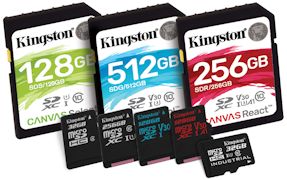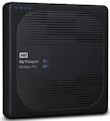Kingston Canvas SD and microSD Cards
It's Holiday Tech season, and my first topic is SD cards. Yes, memory cards are not terribly exciting, except when you lose your microSD cards because they are so tiny. On the other hand, memory cards are a wonderful exemplar of the relentless advance of technology. You want better, faster, cheaper? No problem --You can have all three!
After all, a half terabyte of storage (512 GB) in a small card is pretty interesting, especially when you need to record huge volumes of data like HD video. And a quarter terabyte (256 GB) on a teeny card that fits in your smartphone to store large libraries of videos, photos, podcasts, and apps is rather pleasant as well. Meanwhile, the cost of 256 GB has dropped to around $70, while the step up to 256 GB is still a jump to around $250.
So the good news is that the memory card industry has done a great job of improving and enhancing these cards while lowering the cost. However, the resulting profusion of card sizes, capacity, speeds, and classes (with their accompanying nomenclature and logos) really confuses the task of choosing a card.
 Kingston SD and microSD cards
Kingston SD and microSD cards
If you want the gory details, the industry has settled on three different (but complimentary) metrics for describing SD cards (and similar for microSD), based on the names for standards that were developed for each advance in card technology:
- Capacity - SD (2 GB), SDHC (32 GB), SDXC (2 TB), SDUC (128 TB)
- Bus Speed - Default 12.5 MB/sec, High Speed 25, UHS-I 104, UHS-II 312, UHS-III 624, SD Express 985
- Class / Min Sustained Write Speed - Class 2/4/6 - SD to HD; U/UHS 10/30 - Full HD to 4K; V/Video 60/90 - 4K to 8K video (Class number is MB/sec)
As a result, the labelling of any SD card should use these terms to describe its storage capacity (GB to TB) and performance, where the speed is defined both in terms of the maximum transfer bus speed (theoretical burst performance) and the real-world minimum sustained write speed (e.g., for continuously streaming video).
This is nice technical information, but not particularly convenient to the consumer looking at racks of SD cards in the store. As a result, companies have turned to the thesaurus to apply a profusion of laudatory adjectives. But this is not terribly helpful -- After all, is "Extreme" better than "Ultra", or maybe "Select"? And what does an additional "Plus" or "Elite" or "Professional" mean?
This year, the Kingston Canvas line of SD and microSD cards is using a different approach by segmenting its memory card line into three lines, based on the demands of the devices in which the cards are to be used:
- Basic point and shoot cameras, without heavy video.
- More advanced consumer-grade DSLR cameras and basic video cameras (e.g., smaller, lighter devices to use for action cams or drones).
- High-end high-res and high-rate professional cameras (e.g., DSLRs with burst recording of HD images, mirrorless cameras, and 4K video cameras).
This provides a useful way of organizing cards first by need, and then mapping the need to technical specs (and the associated logos on the product packaging). Kingston does use its own nomenclature for these three categories: Select (basic), Go! (consumer), and React (pro):
Canvas Select SD - Point and Shoot Cameras
Class 10 UHS-I speeds - up to 80MB/s read, 10MB/s write
SD - up to128 GB $43 ($31)
microSD - up to 256 GB $103 ($59)
Canvas Go! SD - DSLRs, Drones, Action Cameras
Class 10 UHS-I U3 speeds - up to 90MB/s read, 45MB/s write
SD - up to 256 GB $90 ($72), 512 GB $250 ($249)
microSD - up to 128 GB $54 ($34)
Canvas React SD - DSLRs (Burst), Mirrorless Cams, 4K Video
Class 10 UHS-I U3 speeds - up to 100MB/s read, 80MB/s write
SD - up to 256 GB $110 ($77)
microSD - up to 256 GB $80 ($79), 512 GB $237
The bottom line for most consumers, then, is that the middle range of products is probably more than what you'll need for consumer cameras, video cameras, and smart devices. The current price curve makes 256 GB look quite affordable, again providing what should be more than enough for typical needs. If you have a more professional device, check the manual for any additional requirements.
- See full Holiday Tech 2018 presentation for my local talks in the Princeton area
- See companion article in U.S. 1 Newspaper, Nov. 14, 2018
![]() Find the Kingston Canvas SD Card Line on Amazon.com
Find the Kingston Canvas SD Card Line on Amazon.com

 Otherwise, you can use a card reader like the
Otherwise, you can use a card reader like the  But USB 3.0 is so old hat -- USB Type C is the new, better connector that is now being used on both laptops and on portable devices including smartphones and tablets.
But USB 3.0 is so old hat -- USB Type C is the new, better connector that is now being used on both laptops and on portable devices including smartphones and tablets.  The
The  Similarly, the
Similarly, the  You can start with the
You can start with the  Then the
Then the  The
The  The
The